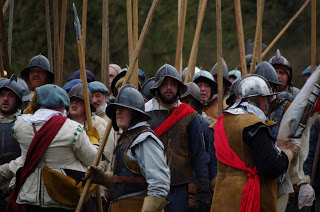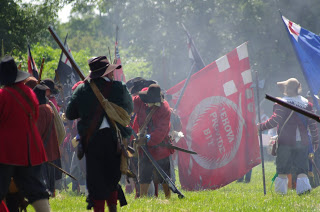Sir Thomas Tyldesley's Regiment of Dragoons
A jolly to Paris led to a slight painting detour via Napoleon's Rheinbund regiments, but I'm back in seventeenth century England again.
What do we know about Tyldesley's Dragoons? In a nutshell - not a lot to be honest. We know that Thomas Tyldesley commissioned William Blundell to captain a company of dragoons. Blundell had got himself into trouble ''inciting riots" in the 1630s so was probably quite suited to a military life.
What do we know about Tyldesley's Dragoons? In a nutshell - not a lot to be honest. We know that Thomas Tyldesley commissioned William Blundell to captain a company of dragoons. Blundell had got himself into trouble ''inciting riots" in the 1630s so was probably quite suited to a military life.
Thomas has the dubious distinction of claiming the first recorded casualty of the First English Civil War. A street fight on 15th July 1642, claimed the life of Levenshulme linen weaver Richard Perceval, when Royalists tried to force the town to hand over its gunpowder stores. Perceval, was allegedly killed by Thomas Tyldesley. Proceedings were begun against Thomas for the killing; however, on 11th August the House of Commons ordered the judges in Lancashire to cease the action.
Most likely raised in Lancashire, believed to have done some rough stuff in Lancaster, Bolton, Preston and the Battle of Whalley Abbey (no, I haven't heard of this battle either). All goes quiet after 1643: specific references dry up after Captain Blundell had his thigh bone shattered by a musket ball in the assault on Lancaster.
Carbines were issued to the 'horse' late in 1643, these were most likely destined for the company of dragoons; they are believed to have participated in Marston Moor, albeit possibly incorporated into Tyldesley's Regiment of Horse.
Tyldesley's Horse and Foot were both at Nantwich, and accompanied Rupert on his march to York. If the dragoons still existed as a separate unit it would be fair to assume that they too were present alongside Tyldesley's other regiments.
Sir Thomas Tyldesley's Regiment of Foot is part of the English Civil War Society re-enactment society. They wear white coats and field red and white gyrony colours.
There are a number of historical references which suggest the regiment of foot wore red coats; there is also a reference to "green flags bearing numbers of white crosses upon them" at Marston Moor, which are most likely Tyldesley's. His Cornet of Horse is known - a pelican and motto upon a green background (the BCW regimental wiki describes Dalton's cornet).
Sir Thomas was a Lancastrian who served as a Lieutenant Colonel at Edgehill (probably because he raised regiments of foot, horse and dragoons). Knighted after the storming of Burton on Trent. Afterwards he was present at the Bolton Massacre, and became Governor of Lichfield. Killed in action at the Battle of Wigan Lane in 1651 (by now a Major General). Sir Thomas has his own volume printed by Partizan Press (it might be a coincidence that Stuart Reid was the CO of Sir Thomas Tyldesley's ECWS Regiment, which considering his findings re:coat and colours in his booklet, makes me wonder why the re-enactors wear white coats and carry a red and white gyronny colour).
There is quite an impressive monument on Wigan Lane (junction with Monument Lane) WN1 2LR in Wigan, which is supposedly the site of his death.
Seeing as we know nothing definite about coat colours and guidon I had free rein to do what I wanted: I fancied a red regiment of dragoons, not a bright madder red, more of a burgundy red. A red shade like the uniforms of these Sealed Knot re-enactors. Fortunately Foundry make the perfect shade, unsurprisingly called "wine stain".
As for their guidon, well I initially decided upon a plain burgundy coloured guidon (replicating the coat colour I chose) with the cross of St George, which Stuart at Maverick was happy to produce for me. After much prevarication - possibly green foot colours, green background to horse cornet... it's really going to be a green dragoon cornet isn't it?
Most likely raised in Lancashire, believed to have done some rough stuff in Lancaster, Bolton, Preston and the Battle of Whalley Abbey (no, I haven't heard of this battle either). All goes quiet after 1643: specific references dry up after Captain Blundell had his thigh bone shattered by a musket ball in the assault on Lancaster.
Carbines were issued to the 'horse' late in 1643, these were most likely destined for the company of dragoons; they are believed to have participated in Marston Moor, albeit possibly incorporated into Tyldesley's Regiment of Horse.
Tyldesley's Horse and Foot were both at Nantwich, and accompanied Rupert on his march to York. If the dragoons still existed as a separate unit it would be fair to assume that they too were present alongside Tyldesley's other regiments.
Sir Thomas Tyldesley's Regiment of Foot is part of the English Civil War Society re-enactment society. They wear white coats and field red and white gyrony colours.
There are a number of historical references which suggest the regiment of foot wore red coats; there is also a reference to "green flags bearing numbers of white crosses upon them" at Marston Moor, which are most likely Tyldesley's. His Cornet of Horse is known - a pelican and motto upon a green background (the BCW regimental wiki describes Dalton's cornet).
Sir Thomas was a Lancastrian who served as a Lieutenant Colonel at Edgehill (probably because he raised regiments of foot, horse and dragoons). Knighted after the storming of Burton on Trent. Afterwards he was present at the Bolton Massacre, and became Governor of Lichfield. Killed in action at the Battle of Wigan Lane in 1651 (by now a Major General). Sir Thomas has his own volume printed by Partizan Press (it might be a coincidence that Stuart Reid was the CO of Sir Thomas Tyldesley's ECWS Regiment, which considering his findings re:coat and colours in his booklet, makes me wonder why the re-enactors wear white coats and carry a red and white gyronny colour).
There is quite an impressive monument on Wigan Lane (junction with Monument Lane) WN1 2LR in Wigan, which is supposedly the site of his death.
The monument originally bore this inscription: An act of gratitude erected this monument, and conveighs the
memory of Sir Thomas Tyldesley to posterity, who served K. C. 1st as left. Col.
at Edgehill Battell, after raised regiments of horse, foot and dragoons, and
for the desparate storming Burton-on-Trent, over a bridge of 36 arches, received
the honour of knighthood. He afterwards served in all the warrs in great command,
was Governour of Litchfield,/ and
followed the fortune of the Crown through the 3 Kingdoms. Would never compound
with the rebels, though strongly/ invested, and on the 25th aug., 1651, was
here slain, commanding as major general under the E. of Derby, to whom the
grateful erector, Alex. Rigby, Esq., was cornet, and when he was high sheriff
of the County of Lancaster, anno 1679, placed this high obligation on the whole
family of the Tyldesleys.
The recently restored monument also bears this, slightly more modern inscription (which is very difficult to read due to weathering): An act of gratitude which conveys the memory of Sir Thomas Tyldesley to posterity. Who served King Charles the First, as Lieutenant Colonel at Edgehill Battle, after raising regiments of horse, foot and dragoons, and of the desperate storming of Burton-on-Trent over a bridge of 36 arches, received the honour of knighthood. He afterwards served in all the wars in great command, was Governor of Lichfield and followed the fortune of the crown through the Three Kingdoms and never compounded with the rebels, though strongly invested. And on the 25th August, A.D. 1651 was here slain, commanding as major general under the earl of derby. To whom the grateful erector alexander rigby esq. Was cornet when he was high sheriff of this county A.D. 1679. Placed this high obligation on the whole of the family of the Tyldesleys, to follow the noble example of their loyal ancestor.
Seeing as we know nothing definite about coat colours and guidon I had free rein to do what I wanted: I fancied a red regiment of dragoons, not a bright madder red, more of a burgundy red. A red shade like the uniforms of these Sealed Knot re-enactors. Fortunately Foundry make the perfect shade, unsurprisingly called "wine stain".
As for their guidon, well I initially decided upon a plain burgundy coloured guidon (replicating the coat colour I chose) with the cross of St George, which Stuart at Maverick was happy to produce for me. After much prevarication - possibly green foot colours, green background to horse cornet... it's really going to be a green dragoon cornet isn't it?
M'lady's horse: niche reference
If you enjoyed reading this, or any of the other posts, please consider supporting the blog.
Thanks.










.jfif)





Another fine regiment. I like the sound of Wine Stain red :-)
ReplyDeleteMany thanks. Wine Stain is appropriate for the spillage on my cutting mat - Foundry acrylic, or a good Burgundy... or both
Delete